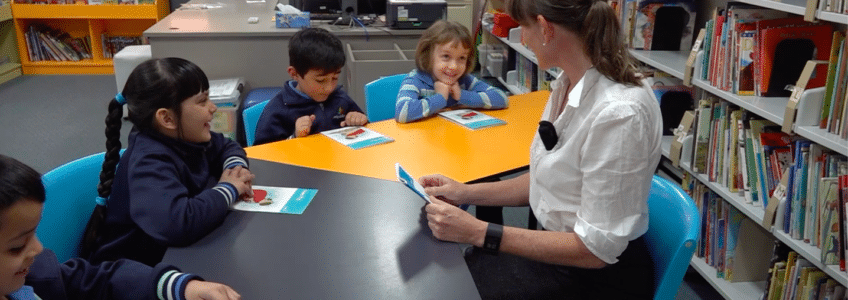
Teacher education reform: Where will all the experts come from?
Share this post Dr Jennifer Buckingham, 20 July 2023 The problems with education in Australia are not new. When the first major Commonwealth government report

Two sides of a single coin – speech-to-print, print-to-speech – let’s not devalue the currency.
By Anna Desjardins
In the world of reading instruction, the terms print-to-speech and speech-to-print have become confusing and unnecessarily divisive. This is because they have been used to categorise both the composite skills required for competent reading and spelling, and whole frameworks within which these composite skills can be taught.
When referring to the composite skills involved in spelling and reading (at the word level):
Both of these skills rely on a knowledge of phonics (how speech sounds correspond to graphemes) and, consequently, phonics instruction is one of the crucial elements required in any comprehensive approach to teaching literacy (alongside explicit instruction in phonemic awareness, fluency, vocabulary and comprehension).
So far, so good. We know children need to be able to translate from print-to-speech when reading, and from speech-to-print when writing. We can help them develop these skills by teaching them phonics. However, now we hit a snag, because phonics can be taught in different ways and, unhelpfully, a dichotomy has developed between phonics instruction categorised as ‘print-to-speech’ versus instruction categorised as ‘speech-to-print’.
What do these labels mean in the context of instruction? Given the definitions above, you could be forgiven for thinking that in one approach children are taught only how to decode or read, while in the other they are taught only how to encode or spell. But this is not what is intended.
When used to categorise the whole framework within which phonics is taught:
The development of these two modern instantiations of phonics instruction can be best understood by taking a look at the history of phonics instruction more broadly.
Phonics instruction can be traced back as far as the Ancient Greeks. The Greeks introduced vowels to their alphabet expressly to be able to represent the sounds of spoken language more efficiently and archaeological remains on shards of Greek clay pots testify to the fact that the sounds different letters made were explicitly pointed out by means of syllable-building activities (Foster, 2004). Our Roman alphabet is descended from the Greek alphabet and the idea that phonics instruction would be a useful way to gain access to the Roman alphabetic code has similarly been around for a long time. For example, some of the oldest approaches to teaching reading in the United States in the late 1700s favoured a phonics approach. Indeed, this remained the standard for over a hundred years. Then, in the 1920s to the late 1960s, the consensus in the U.S. turned towards teaching whole words by sight (Chall, 1989). Dissatisfaction with this whole-word approach grew, however, and a newer wave of phonics-based approaches began to appear by the 1950s.
Print-to-Speech Methods
The advent of a number of more modern phonics instruction techniques can be attributed to work done in the 1930s and 40s by Samuel Orton and Anna Gillingham (Nicholson, 2011). In particular, Orton wanted to move away from the then popular whole-word approach, because he thought that relying on visual processes alone was likely to cause reading problems. He recommended teaching children the sounds of the letters and how to blend the sounds together to reproduce the spoken form of the written word. Gillingham later put the Orton-Gillingham (OG) ideas into a manual written with Bessie Stillman (Gillingham & Stillman, 1960, 1997).
With the push to reintroduce phonics to reading instruction programs in the U.S. in the 1960s, various OG approaches sprang from Orton and Gillingham’s work and they are still around today. Though they differ quite substantially, they all tend to take a print-to-speech tack, teaching a list of phonics rules organised around the letters and phonograms of English. As OG approaches multiplied, however, they became a disparate bunch. They are perhaps best known nowadays for including a multisensory, tactile component to their instruction – children might trace letters on paper, in the air or in sand, and they are instructed to pay attention to how their mouth feels when producing the sounds of letters. This kinaesthetic dimension of instruction does not have strong research support (Shanahan 2020) and the OG methods are otherwise too dissimilar to each other to allow for any meaningful comparison to other approaches to be made. Consequently, the evidence-base for their effectiveness is inadequate (Ritchey & Goeke, 2006). Nonetheless, OG methods do teach phonics in a systematic way and we know that systematic phonics instruction (of some kind) is critical when teaching literacy.
Unfortunately, by the 1980s, phonics was again largely abandoned in the U.S. and other English-speaking countries in favour of the whole-word approach (this time slightly modified and renamed ‘whole language’). But as researchers have continued to amass a wealth of evidence demonstrating, unequivocally, the effectiveness of phonics instruction (and particularly of synthetic phonics instruction) for teaching reading, phonics-based approaches have begun to flourish again in the U.S, the U.K. and Australia. Now that phonics is becoming increasingly accepted, debate has turned to a more fine-grained issue: how best to organise and present the grapheme-phoneme correspondences that must be taught.
Print-to-speech approaches take as their starting point that the spelling system is stable over time and organise instruction around a systematic sequence of graphemes. However, note that although their sequence of instruction may be organised in this way, print-to-speech methods do not rule out using speech-to-print aspects of instruction; for example, they typically include phonemic awareness activities, designed to cue children into the speech sounds in words in the absence of print. It’s also important to note that within this framework, children do not only work on the skill of decoding; they engage in both reading and spelling words.
Speech-to-Print Methods
Speech-to-print approaches, on the other hand, organise instruction around a systematic sequence of phonemes. These have developed, perhaps, in response to what can seem to be unnecessarily long lists of phonics rules in some print-to-speech approaches. The idea is that instead of organising instruction around 70+ phonograms, a sequence of lessons can be organised around the 44 phonemes of English. Similarly to the print-to-speech methods, however, within the determined sequence of speech-to-print lessons, children engage in both encoding and decoding activities.
These methods take as their starting point that speech is primary: historically, speech preceded writing systems, and developmentally, speech is acquired before reading or writing skills. The idea of starting with what the child knows (speech) and mapping new knowledge (print) onto that seems like a good one. However, it’s worth bearing in mind that knowledge of speech sounds is unconscious, so linking phonemes to graphemes is not necessarily any easier than linking graphemes to phonemes. In fact, just like print-to-speech methods, speech-to-print methods need to be coupled with phonemic awareness activities to help children become consciously aware of the speech sounds in words.
It is also not necessarily straightforward to design a speech-to-print scope and sequence for synthetic phonics instruction. Think for a moment about what a sequence based only on considerations of speech might look like. Faced with choosing which of the 44 phonemes to teach first, it might seem logical to start with sounds that are maximally distinct from each other. This can certainly be helpful – teaching consonants that differ in voicing, place and type of articulation in close succession (e.g., the voiced bilabial nasal /m/ and the voiceless dental fricative /s/) will make distinguishing these sounds for children very easy as teachers engage in phonemic awareness activities. However, determining the sequence on these considerations alone will also lead to some illogical decisions. For example, the short vowel sound /i/ (as in igloo) is high and front in the mouth, with no lip-rounding. The vowel sound with the opposite characteristics, and therefore the most maximally distinct, is /aw/, which is low and back in the mouth, with lip-rounding. Should these two sounds be taught in close succession? This would involve teaching children the link between /i/ and the single letter ‘i’ and the link between /aw/ and at least one digraph ‘aw’ or ‘au’ or ‘or’ (or possibly an even more complex grapheme like ‘ore’, ‘augh’ or ‘ough’). Rather, the complexity of various grapheme choices, along with the frequency with which they appear in words, need to be considered alongside speech sound differences.
Another possible instantiation of the speech-to-print approach is to teach all possible graphemes for a phoneme when that phoneme is introduced. This means children are presented with large amounts of information (e.g., learning six possible ways to read or spell the sound /aw/), some of which is not immediately useful to them and can lead to cognitive overload. Some spelling choices for a sound are infrequent; some may occur in words that are too sophisticated for 5-year-old children. Take the seemingly innocuous /i/ vowel example above. In an approach that teaches all possible graphemes for a sound, /i/ would need to be linked with both ‘i’ and ‘y’. Although, as a single letter, ‘y’ is a relatively simple grapheme, it tends to be used to represent the /i/ sound in words of Greek origin which are outside the experience of most 5-year-olds (e.g., myth, symbol, system, oxygen, crypt, hymn, cygnet). This example illustrates that even when the complexity of the grapheme choices remains manageable (single letters), and the spelling choices appear in a large number of words, usefulness of those words to a child just learning to read should also play a role in determining what gets taught when.
In fact, Louisa Moats, who promotes a speech-to-print approach in her aptly titled book Speech to Print (2020) does not recommend providing all of the graphemes that represent each phoneme at once. Instead, she recommends a simple-to-complex sequence, teaching common correspondences and patterns before less common ones. Following this advice, we would teach children the common /s/ – ‘s’ association, before teaching them the less common /s/ – ‘c’ association in words like ‘city’, ‘cement’ and ‘cymbal’, for example.
Which Instructional Approach is Best?
In essence, the print-to-speech vs. speech-to-print debate has set up a false dichotomy in how reading should be taught. As should now be apparent, the distinction between the two frameworks is not dramatic, because both approaches agree that a sequence of sound-grapheme correspondences needs to be taught explicitly and systematically. And both approaches, if well-designed, need to take into consideration both speech and print when determining that sequence. While there is no ‘gold standard’ order of grapheme-phoneme correspondence (GPC) instruction, there is general expert consensus that GPCs should be introduced on the basis of:
While some children with reading difficulties may need to be taught every phoneme-grapheme association explicitly, the over-arching aim of either approach should be to move towards spending progressively less time on explicit phonics instruction and more time on reading connected text, to foster the self-teaching required for automatic reading skills to develop.
Finally, in any good sequence of phonics instruction (be it a ‘print-to-speech’ method or a ‘speech-to-print’ method), children need to engage in phonemic awareness activities and in activities that require them to apply their phonic knowledge in both directions: from print-to-speech (e.g., by practising reading single words, sentences and short passages) and from speech-to-print (e.g., by practising building words, spelling words, and writing words in short sentences and passages). These are reciprocal skills, based on the same underlying knowledge, and research has shown that instruction in one supports the other (Joshi, Treiman, Carreker, & Moats, 2008; Moats, 2005; Post, Carreker, & Holland, 2001).
Indeed, recent brain-scanning research has shown that there exists a neurological circuit for reading, and this involves a fast and bi-directional connection between visual and phonological areas of the brain (Dehaene, 2013). This lends physical support (in the shape of a bundle of axons) to the behavioural research – the implication is that to optimize the establishment of this circuitry during reading instruction, children should be systematically taught how letters map to speech sounds and vice versa, and should work on these connections in two directions: from print to speech, and from speech to print. There is no need for these two terms to be pitted against each other, when in fact, they are two sides of a single coin.
Dr Anna Desjardins (Notley) is a product developer at MultiLit and is a member of the MultiLit Research Unit. Anna has a Research Masters in Linguistics from the University of Amsterdam and a PhD in Cognitive Science from Macquarie University. Prior to joining MultiLit she worked as a research assistant on a range of child language development projects at the University of Western Sydney and Macquarie University. https://multilit.com/about/our-expertise/anna-desjardins/

Share this post Dr Jennifer Buckingham, 20 July 2023 The problems with education in Australia are not new. When the first major Commonwealth government report

Share this post Dr Jennifer Buckingham, 23 June 2023 As greater consensus has been reached about how to teach children to decode and read words

Share this post In September, the Productivity Commission released an Interim Report from its Inquiry into the National School Reform Agreement (NSRA). The NSRA is

Want to drop us a line? You can get in touch by filling out the form below and we’ll get back to you as soon as possible!